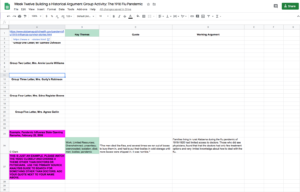Every day our social media threads and email inboxes are inundated with perspectives about the best way to deliver remote instruction. I have added my own two cents to the milieu of advice as well. However, what I have found is that the most effective way to adapt to my new teaching reality is to ask my students what works for them rather than assuming I know what is best. For example, during our first week of remote learning, I assigned a reflection of a lecture I posted about the Gilded Age. I scheduled the reflection due two days after I posted the video Two days later, only a few students had submitted their response. I panicked. What happened? I eased my anxiety by sending a personal message to each of them to ask why they had not responded to the prompt. Each student explained their situation to me, and from their replies, I discovered what I needed to do to adapt the due dates to fit their needs. For instance, some students said that they are now in charge of their younger siblings during the day and could not complete work until the weekend. Other students said they feel overwhelmed by the online learning environment. A couple admitted that they were simply lazy and waited until the last minute and then couldn’t complete the work by the due date. As a result of this one-on-one communication, I was able to make the adjustments to my course to help each student succeed.
I, like everyone else, am struggling to find new ways to adjust my face-to-face activities to the remote classroom. Gaining student perspectives has helped me to envision how best to coordinate those activities that I consider essential to student success. For example, every semester, I conduct an in-class historical argument building activity. I provide each student one of six letters written by a representative from a different Utah county who is hoping to secure additional money to fund Civilian Conservation Corp (CCC) projects in their area. I also provide each student with a sheet that outlines the historical context of President Franklin D. Roosevelt’s New Deal and the CCC. I also give them a primary source analysis guide. I then ask each student to analyze her/his/their letter using the guide. As they work, I write the name of each author separately on the whiteboard which looks similar to the following:
Wm. H. Callahan, March 8, 1937 Afton P. Crocker, March 9, 1937
Utah County Duchesne County
I instruct the class to choose a quote from their letter that best represents the main point the writer made about the CCC. They then write the quote underneath the author’s name on the whiteboard. I ask the students to compare and contrast the different quotes to look for commonalities. Common themes from the letters are typically related to masculinity and/or economic class. The students and I discuss the common topics that they observed. We draw conclusions about the dates of the letter, and then I write several historical arguments on the board and demonstrate how to use each letter in a paper to support each one.
Adapting this activity for the remote learning environment was the most challenging task I have had yet. First, I scrapped the Great Depression-themed exercise and replaced it with oral interviews from survivors of the influenza pandemic of 1918-1920. I recorded a video demonstrating how to analyze an oral interview. During my presentation, I also chose a quote from each interview related to medical treatment and explained how I found the theme and then typed a historical argument based on my observation. Finally, I created a Google spreadsheet where I broke the class into groups, assigned each student one of the interviews, and then asked them to use the primary source analysis guide to study their interview. I instruct them to post the quote that they felt best represented the interviewer’s main point and to write their historical argument in a separate box. I assigned this activity on a Tuesday and made the work due on that Friday. After the due date, I recorded a video where I analyzed their quotes and discussed their findings. My students did spectacular considering the challenge of this activity. I enjoyed reviewing and discussing their findings and can tell that they have grasped the main objectives. They are now prepared to finalize their historical argument for their upcoming final research paper project due at the end of April. The remote group activity looks like this (please note that I did not include the student names in this example to respect their privacy. Click on the image for clarity):
Acclimating to a successful remote learning environment requires flexibility and a willingness to consider the perspective of each student. While the situation is not ideal, our students want to learn, and they will do what they can to complete work. I enjoyed designing and watching the argument-building activity I described above unfold, and I am grateful that I can continue to help my students develop critical thinking and writing skills even if it is from afar.


